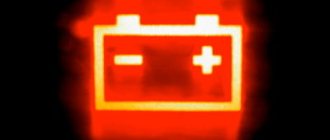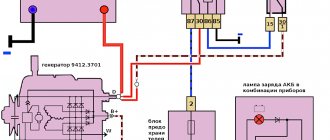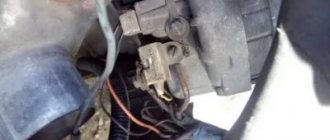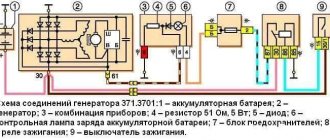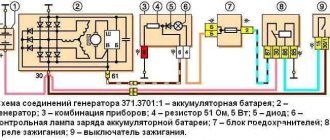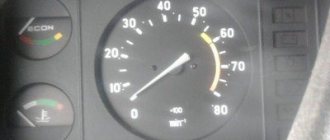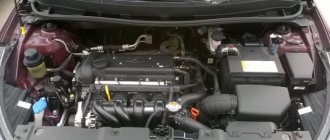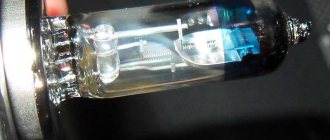Your car has two power sources, a battery and a generator. The first of them fed the electrical circuit when the engine was not running. Second source during engine operation. In this case, the battery switches to receive electricity and supplements the energy consumed to start the engine.
In practice, failures of one or a second power supply are quite common. They often open up in the same way. The starter does not want to turn the engine and as a result, the engine does not start. When the engine is running, the battery indicator light illuminates on the switch. This means that an error has occurred and the battery is not loaded.
Malfunctions of the VAZ 2108, 2109, 21099 generator
The generator is responsible for power supply to the entire on-board network of the car with the engine running. Signs of a malfunction of the generator of VAZ 2108, 2109, 21099 cars
After starting the engine, the battery discharge indicator lamp in the instrument panel lights up
The generator does not produce the required charging current. Simultaneously with the light on, the voltmeter readings tend to zero. The battery is constantly not recharged. Using a voltmeter (multimeter), we check the voltage at the battery terminals (the engine is idling). The voltmeter readings should be as follows: generator 37.3701 - 13.6 V, generator 9402.3701 - 13.2 V.
The “folk” method of checking a generator by removing the terminal from the battery while the engine is running is only suitable for carburetor engines. If the engine stalls after removing the terminal, it means the generator has stopped producing electric current.
If it is less, then the problem is not in the faulty wiring going to the control lamp and voltmeter, but in the generator. Next, sequentially, from simple to complex, from the most probable to the least probable, we look for the cause of the malfunction.
— The generator drive belt tension is loose
The belt slips on the pulley, and the generator rotor stops rotating at the required frequency. In this case, a “whistle” from the generator drive is possible. We check and adjust the belt tension if necessary.
— The generator voltage regulator is faulty
There may be a short circuit between its terminals “B” (“D+”), “W” (“DF”) or “stuck” (the brushes of the brush assembly have worn out). The easiest way to check the voltage regulator is to install a known good one. We replace the faulty regulator with a new one. Read more: “Checking the generator voltage regulator for VAZ 2108, 2109, 21099 cars.”
— The diode bridge (rectifier unit) of the generator is faulty
Most likely there is a “break” in its valves or a short circuit in the negative valves. The power diodes of the excitation winding may also be damaged. The diode bridge can be checked using an ohmmeter (multimeter in ohmmeter mode) both directly on the car and on a removed generator.
Checking the diode bridge of the generator of VAZ 2108, 2109, 21099 cars
— The generator stator is faulty
“Open” or short circuit in the stator winding. We check the stator with an ohmmeter, and if there is a malfunction, replace it with a new one.
checking the stator windings of generator 37.3701 for “break”
— The generator rotor is faulty
Perhaps the leads of the excitation winding located on the rotor have become detached from the contact rings to which the brushes are pressed. We check the rotor and replace it with a new one if necessary.
generator winding terminals 37.3701 for VAZ 2108, 2109, 21099 cars
The battery is recharged and “boils”
The generator produces too much charging current, higher: generator 37.3701 - 14.6 V, generator 9402.3701 - 14.7 V, which is checked with a voltmeter at the battery terminals. The needle on the standard voltmeter is in the red zone at the end of the scale.
— The voltage regulator is faulty
Most likely there is a short circuit between its terminal “Ш” (“DF”) and “ground”. Replace the voltage regulator with a new one or a known good one.
The generator makes noise or “howls” when operating
The nut securing the generator pulley has come loose, the generator bearings are worn out, there is an interturn short circuit or a short circuit to ground in the stator winding (the generator “howls”), a short circuit in one of the generator valves.
Notes and additions
— The causes of such malfunctions as: the warning lamp does not light up after turning the key in the ignition switch and starting the engine (the standard voltmeter shows normal voltage) or the lamp does not light up and the voltmeter does not work (or the control devices do not work completely) are not a malfunction of the generator, but a burnout of the control panel lamp, a break in its power supply circuit, a blown fuse No. 5 (F16) in the mounting block (responsible for supplying current to the excitation winding of the generator), a break in the power supply circuit of the instrument cluster (orange and orange-blue wires), a malfunction of the ignition switch.
— If the discharge warning lamp lights up at idle, and goes out when you press the gas pedal and while driving, you must first check the tension of the generator drive belt, and if that doesn’t help, then the problem is most likely in the additional resistors located in the relay mounting block and fuses. If they fail, the generator is not excited at low speeds, and therefore does not charge. It is necessary to either completely change the mounting block, or unsolder additional resistors and replace them with new ones.
More articles on generators for VAZ 2108, 2109, 21099 cars
How to test a generator with a multimeter
The alternator diode bridge can be tested using a multimeter, but you can also use the stand that was used to test the regulator.
However, first of all, without removing the rectifier bridge from the alternator, connect the red test lead to terminal 30 of the alternator, and the black lead to the housing. Set the tester operating mode to diode (diode icon). If it is not there, set it to 1-2 kOhm. The multimeter should show infinity. If the readings are different, the diode bridge is faulty.
Then check that the rectifiers are not damaged. Leave the positive sensor (red) on terminal 30 and the negative sensor in alternate contact with the jumper mounting screws. The multimeter readings should show infinity in all cases, with any other signs of malfunction.
Then connect the positive sensor to the axle mounting bolts and the negative sensor to the generator housing. In this case, the tester should also give infinity.
However, in practice such verification is usually not enough. In most cases, it is necessary to perform a more detailed check of the generator.
Careful testing
To do this, unscrew the screws securing the rectifier unit, disconnect the copper wires of the stator winding and remove the diode bridge from the generator. Now you can test each semiconductor separately. Before checking, it is recommended to rinse the stabilizer under running water using a medium-hard brush, and then dry thoroughly. A hairdryer is good for quick drying.
Attach one of the tester probes to the diode board, and connect the other probe to the center contact of each diode attached to the board. Then swap the sensors. In one case, the multimetron should indicate infinity, in the second - a nominal resistance of about 570-590 Ohms. Rectifiers are considered faulty if:
- In the first and second measurements (with reverse polarity), the multimeter readings coincide;
- The diode resistance is greater or less than the nominal values.
Do the same with the second plate of the diode bridge. If one or more diodes fail, it will be easier to replace the entire rectifier assembly. True, there are craftsmen who replace damaged diodes separately, but such work requires a certain skill and dexterity.
Checking the armature and stator windings
The generator must be completely disassembled for further testing. First of all, you should visually check the fittings. Brush rings should be free from darkening, spattering and raceway wear. Black spots and minor signs of wear can be removed with a cloth. Rings with deep grooves must be replaced or, if the thickness of the ring allows, turned on a lathe.
The armature winding should not have a distinct burning smell. The color of the winding must be uniform, without damage or tears. A multimeter is needed to check the armature winding for gaps. Set it up to test or measure resistance and connect the probes to the brush rings. The winding resistance should be from 3 to 5 Ohms. Then leave one probe on the ring and connect the other to the body. The multimeter display should show infinity.
The generator stator is diagnosed outside the housing. First perform a visual inspection. There should be no visible damage to the cable and its insulation. Then connect the probe to the stator housing. Touch the terminals one by one with the other wire. There are three of them in total. The tester must be in test mode. If the display shows infinity, the stator is OK.
A further check is the diagnostics of the windings. The resistance of all three windings must be the same.
Before reinstalling the generator, check the bearings and replace if necessary. They should not jam or squeak when turning. This means that they are very worn and will soon fail. Therefore, it is better to replace them immediately.
One of the main components of any car's electrical circuit is the battery and alternator. We'll talk about the latter in this article. What is the generator of the domestic VAZ 2106 car, what malfunctions are typical for it and how to repair the device, read below.
Causes of generator malfunction on the VAZ-2107 (injector)
Experts suggest that on a VAZ-2107 with an injector, the standard generator is 5142.3771 (eight). It has one very important feature: it produces more current - not 55A per hour, like other generators, but about 80-90 A. This is due to the properties of the injector, which requires more electricity (but also has a higher power density).
Experts advise checking the generator for malfunctions in the following order:
- inspect the diodes that supply electricity to the excitation winding of the generator (if they are burned out, they should be replaced with new ones);
- use a tester to measure the voltage level in the current-carrying circuit (if its value is less than 12 V, then there may be a short circuit, which means the wiring is overheating).
If it is difficult for the car owner to carry out such diagnostics, he can contact the nearest car service center for help from qualified specialists.
Generator overload
If the battery is charging, but the voltage is insufficient, it means the generator is overloaded. This is facilitated by the installation and connection, in addition to standard electrical equipment, of various gadgets that require electricity. The generator is operating at the limit of its capabilities.
Modern drivers love various car tunings. Thus, serious music systems, powerful lighting and other equipment are installed. Someone also increases the battery power. So, with a 70 Ah battery, the standard VAZ generator cannot fully charge it. It just doesn't have enough power. As a result, the generator provides little charge.
No charge or bad charge.
If the value is less than the minimum allowable, check the voltage without load. It is also necessary to measure the voltage between terminal 30 of the generator and its housing. If, when checking the VAZ 2107 generator, the voltage value, when the high beam headlights are turned on, at the battery terminals is below 13.5.V, and when the lights are off, the voltage slowly increases to a value of 13 - 13.4V. The reason in this case must be sought in poor contact from terminal 30 of the generator to the battery, poor contact between the negative terminal and the engine housing.
To check the reliability of the connection in terminal 30 of the generator, it is necessary to measure the voltage between the terminal and the generator housing. If the voltage is significantly higher than the value at the battery terminals, then you should unscrew the nut securing the wire and clean the connection points and stretch the nut of the terminal itself located between the wire and the generator. Poor contact in this place will also be accompanied by strong heating of the contact bolt. If the voltage at the output is more than 13.5.V, then take a measurement between the positive terminal of the generator and the generator housing. If the value is equal to the voltage between terminal 30 of the generator and its housing, eliminate the contact between the negative terminal of the generator and the engine housing. If the value is less, then check the voltage value in the contact connections of the circuit from the generator to the battery. If the voltage value at the battery terminals and terminal 30 of the generator are the same, then the generator itself is faulty. The most common malfunction in this case is a breakdown of one diode of the rectifier bridge.
Voltage regulator malfunction.
If, when checking the VAZ 2107 generator, the voltage at the battery terminals is the same with the high beams on and off. In this case, the voltage value between terminal 30 and the generator housing does not differ from the voltage value at the battery terminals. This is possible if the generator voltage regulator is faulty or there is no voltage for the initial excitation, or the generator itself is faulty.
First you need to check the presence of voltage to excite the generator. It is better to do this using a test lamp, connecting one end to the housing, and the other to a wire suitable for the generator brushes or terminal 61 of the generator, if the generator has a built-in voltage regulator. If there is no power on the wire, then it is necessary to check the integrity of the wires, the fuse and the serviceability of the voltage regulator on cars with a remote regulator.
Built-in voltage regulators must be checked when there is power, on the wire connected to them or terminal 61 of the generator. How to do this is described in the article “Checking the voltage regulator” and there is no point in dwelling on this issue here. If the excitation power is suitable and the regulator and brush assembly are in good working order, then the fault must be looked for in the generator.
Drive belt slipping.
Let's consider another version of the events identified when checking the VAZ 2107 generator. After starting the engine, without turning on the load, the voltage value is less than normal, but after some time it returns to normal. When the load is turned on, it drops sharply. The drop may also be the result of a sharp increase in engine speed, followed by normalization when operating at constant speed. This indicates slippage of the generator drive belt, which can be caused by weakening or wear of both the belt itself and the pulleys. Wear in this case can be easily determined by the presence of shine on the bottom of the pulley. In this case, the belt must be replaced; tightening it is useless in this case. Moreover, an over-tensioned belt can cause destruction of the generator bearings.
When installing a new belt, you need to pay attention to the amount of its immersion in the pulley groove. If the belt fails completely, the pulley must also be replaced. Well, finally, and lastly, when the voltage at the battery terminals when checking the VAZ 2107 generator is above 14.5V
this indicates a malfunction of the voltage regulator or poor contact at its negative terminal with the generator housing if the regulator is installed built-in or with the car body if installed remotely
Well, finally, and lastly, when the voltage at the battery terminals when checking the VAZ 2107 generator is higher than 14.5V. this indicates a malfunction of the voltage regulator or poor contact at its negative terminal with the generator housing if the regulator is installed in a built-in position or with the car body if it is installed remotely.
10/09/2014
Problems with the battery: charging the VAZ 2106 and diagnosing faults
As a rule, before checking the regulator of a VAZ 2107, 2106 or any other car, it is necessary to review in general terms the design and operating principle of such a regulator.
Let's start with the fact that the design of the regulator may differ. Old VAZ 2106 models have outdated contact regulators. At the same time, newer versions already use an electronic regulator.
So, the contact external regulator is still the basis. This is a semiconductor type device manufactured on a single board. The main element is the winding (brass wire is used), the winding consists of just over a thousand turns, and there is a copper core inside the winding. The winding has a constant resistance of 16 ohms.
How to determine the charge level?
Primary control of the charge level on the VAZ 2107 is carried out by instruments on the panel: a control lamp and a voltmeter. If the charge is normal, the indicator arrow will be in the green area, and the control lamp should go out when the engine is running.
To more accurately check the voltage level, you need a voltmeter. As mentioned earlier, the correct charge is 13.6 - 14.1 volts.
You can purchase a special automotive electronic voltmeter or one combined with a watch. Installed both instead of the standard clock and on the dashboard.
Preparing to Troubleshoot
If a problem is detected, we begin diagnostics. First, let's prepare the tools.
- Multimeter (voltmeter);
- Emery cloth or needle file;
- Knife;
- Pliers;
- 12-volt indicator lamp (control).
Table of energy consumption by different equipment.
Charging the battery is necessary in cases where it takes on part of the load of the energy supply system. How much energy does the equipment in the car need?
| Side lights and vehicle lighting | ~40 watt |
| Headlights and fog lights on both sides | ~250 watt |
| Stove fan at maximum power | ~200 watt |
| Cooling fan runs briefly | ~250 watt |
| Heated rear window | ~150 watt |
| Fuel pump and engine management | ~80 watts |
| Radio (medium sound level) | ~100 watt |
Table 1. Electricity consumption in the car by additional equipment.
By simple calculations we get a total consumption of 1070 watts, which when converted to amperes will be approximately 90A. For many car generators, such a load, and they are the first to take it upon themselves, is at the limit of the equipment’s capabilities. When a certain threshold is reached, the system will transfer part of the load to the battery. Therefore, it is necessary to carefully calculate the characteristics of the generator and battery.
Replacement Tablet Generator VAZ 2107
Replacing a brush make yourself a VAZ 2107 generator
Replacement nozzles VAZ and tips 2107
Welcome friends to the car repair site. Despite the huge number of foreign cars, cars of the VAZ family are still needed and are found among motorists who are knowledgeable about technology and appreciate the advantages of the Russian automobile industry.
Of course, operation and repair are indivisible concepts, and in the event of a failure of a particular unit, fault identification and troubleshooting can be carried out completely independently. Let's look at a simple example of repairing a VAZ 2107 car generator.
Malfunctions and principle of operation of generator brushes
The electrical system of your steel stallion shows defects, when the VAZ 2107 generator does not work, a reddish warning light with a battery symbol lights up on the dashboard.
Quite often, wearing or freezing brushes is a must. Those who are familiar with the mechanism of operation of the generator understand that an excitation voltage is supplied to the armature through the brush, which not only drives the electronic machine (generator), but also regulates its output power.
In particular, the regulation itself is determined by a special device, a relay controller, which can be implemented specifically on the brush holders or installed separately (on earlier models).
READ How to Disassemble the Passat B3 Gas Pump
As a rule, this malfunction manifests itself gradually, initially accompanied by minor interruptions in the operation of the generator, which leads to its uniform failure, but other options are also possible, such as an unexpected malfunction.
How to remove the brushes and check the VAZ 2107 generator
VAZ 2106.
VAZ 2107
, No downtime. parking while shifting gears.
Replace the VAZ 2107 generator brushes yourself
The brush repair itself usually comes down to replacing them, but first you need to remove the brush assembly from the generator body and assess the degree of wear, check for chips and cracks.
replacing generator brushes The VAZ 2107 procedure is simple and usually takes a few minutes, you do not need to remove the generator to replace the brushes, just disconnect the power cable, unscrew the two screws that secure the brush holder housing and carefully remove this assembly, make sure to disconnect the negative terminal in advance .
Warning! The battery(s) must be disconnected when performing any electrical work on the vehicle!
READ Replacing Car Interior Trim With Your Hands
Check the disassembled assembly for freezing, jamming of the brushes and their protruding part, which should be at least 12 millimeters. In case of non-compliance, the part must be replaced. Brushes for the VAZ 2107 generator can be bought at almost any auto parts store.
After fixing the problem or purchasing a new one (it's better to buy small parts with a sample of the old ones so you don't have to change them), install them in reverse order.
Prank tips
If you noticed noise from your car's generator brush before repairs, this may mean that the bearings of the VAZ 2107 generator may be worn out, in which case it is necessary to remove and disassemble the VAZ 2107 generator. A worn bearing has an increased clearance of the rolling elements and is susceptible to it. This is the case replacement with a new one. Keep in mind that premature bearing failure is not only due to lack of lubrication.
Keep in mind that premature bearing failure is not only due to lack of lubrication.
A worn bearing has an increased clearance of the rolling elements and is susceptible to it; this is the case when replacing it with a new one. Keep in mind that premature bearing failure is not only due to lack of lubrication.
This is often caused by excessive tension on the alternator drive belt; in addition, a tight belt can damage the cooling system pump bearing.
Therefore, check this device regularly in accordance with the manufacturer's recommendations. It is better to habitually and regularly inspect the engine compartment while the engine is running; this will allow you to identify and eliminate previously encountered problems at minimal cost.
READ Ford Focus 3 Transmission Error
Correct diagnosis will help you avoid unnecessary work and unexpected breakdowns.
Is it possible to charge a full battery?
Reasons for discharging the VAZ 2110 battery Many motorists know the phenomenon of battery overcharging. It occurs when, for some reason, the voltage regulator starts to work incorrectly, so the voltage at the generator output exceeds 14.5 Volts. The optimal voltage of a fully charged battery is 14 Volts. When the voltage difference between the generator and the battery exceeds one volt, the latter begins to absorb additional energy, which leads to boiling and evaporation of the electrolyte, as well as destruction of the lead plates. As a result, the electrolyte level first decreases, then the battery capacity decreases.
If the generator voltage regulator is working normally, then the voltage is maintained at 14 - 14.5 Volts, due to which the battery avoids overcharging. All this fully applies to stationary battery charging, which is carried out using a special charger.
If the voltage at the output of the device does not exceed 14.5 Volts, then the battery will take the amount of electricity that is necessary to change the density of the electrolyte. When the voltage of the generator and the charger are equal, the rate of absorption of electricity will drop so much that further charging becomes meaningless.
How to determine the lack of battery charge
Checking the battery charge
The easiest way to determine the lack of charging is using the car’s instruments, that is, the charging indicator lamp and the sensor (voltmeter) on the instrument panel. The sensor arrow should be in the green sector, and the battery lamp should not light up when the engine is running. Otherwise there is no charging.
But the best way is to check the voltage on the battery with a multimeter. When there is a charge, the voltage on it lies in the range of 13.6-14.2 V, and when there is no charge, it will only have its own voltage of 12 V (± 0.6 V). Under no circumstances remove the terminals from the battery to check to avoid damage to the RR, ECU and other electronic devices on your car.
To troubleshoot battery charging problems, you must use the following tools:
- control lamp 12 V;
- multimeter with a measuring range of up to 60 V AC and DC voltage;
- flat blade screwdriver;
- shaped screwdriver with a Phillips blade;
- pliers;
- knife;
- emery cloth.
Determining electrical system faults
One of the main advantages of the new VAZ 2109 is fuel injection. This type of supply of the fuel mixture is significantly more economical than the carburetor method. In addition to fuel consumption, the injector also improves the vehicle's driving characteristics. For the injector to work properly, the computer or, as motorists call it, “brains” must also work correctly.
In turn, the operation of the computer, as well as all electrical sensors and devices, directly depends on the constant current power. The device that is responsible for supplying power to the vehicle's devices is called a voltage regulator. The main sign of a malfunction of this element is the readings of the voltmeter on the instrument panel.
Also, if while driving the car your fuel consumption has noticeably increased, but at the same time the car began to pull worse, then this is one of the main signs of failure of the voltage regulator relay. This type of breakdown manifests itself especially well in the dark. At this time, dimensions and other electrical appliances are involved, which significantly increase power consumption. If it is not enough, then the instruments and dimensions light up very dimly - it’s time to change the relay!
Reasons for this phenomenon
Guys, I’ll say a few words about “special” recharging from a charger - many people do this on purpose! REMEMBER! Thus, they increase the density of the electrolyte to the required level - in our range it is approximately 1.27 g/cm3, if the density is lower (already with a charged battery), then the battery may freeze at subzero values. We need to raise it! And how to do it? It’s very simple - you need to evaporate a small amount of water from the electrolyte, thus the acid concentration will increase and the density will increase.
Now “non-special” overcharging, as they say under the hood of the car, its main reasons:
The generator charge regulator relay has failed. This relay “sees” charging, and when it reaches 12.7 Volts, it turns off the power supply from the generator. If this relay fails, then the generator will constantly charge the battery, and its currents are considerable, it will boil very quickly! This is the most common reason. Fortunately, this relay costs a penny. A short video, let's watch.
The generator does not charge the battery
In this case, there may be several possible problems. It is necessary to check the drive belt and fuses.
- First, check the generator drive belt for integrity and normal tension. Normally it is about 10-15 mm. It is recommended to change the alternator belt as the car runs. The number is different for each car. It should be found in the vehicle manual.
- If the belt is fine, check the fuses that match the battery - they may have blown. You can find the location of the fuses in the vehicle repair manual in the electrical section. If the fuse is blown, it should be replaced and then checked again to see if the charge is working.
- If the belt and fuses are in order, you should check the wire running from the generator itself to the battery terminal with the “+” sign. If it is broken, the wire should be replaced.
The main problems with battery charging are listed above; for in-depth diagnostics, you should use special equipment.
Which cars are affected by the problem?
Naturally, the probability of the battery receiving an excess charge on new foreign cars is significantly lower than on products with a significant mileage from the domestic automobile industry. However, there are a number of models where overcharging is considered a common problem.
We are talking about classic VAZ cars. Among the “classics”, this malfunction most often occurs on the “six” (VAZ 2106).
Trucks and some UAZ models are equipped with on-board voltage sensors and sometimes these sensors begin to signal an increase in the charging current between the generator and the battery (18V or more). This is not normal and may lead to rapid overcharging. However, often the problem is in the sensors themselves, which show incorrect information.
Naturally, the probability of the battery receiving an excess charge on new foreign cars is significantly lower than on products with a significant mileage from the domestic automobile industry. Nevertheless, there are a number of models on which overcharging is considered a common problem. We are talking about VAZ cars in the classic version. Among the “classics”, this malfunction most often occurs on the “six” (VAZ 2106).
Malfunctions of the VAZ 2108, 2109, 21099 generator
The generator is responsible for power supply to the entire on-board network of a car with a running engine.
Signs of a malfunction of the generator of VAZ 2108, 2109, 21099 cars
After starting the engine, the battery discharge indicator lamp in the instrument panel lights up
The generator does not produce the required charging current. Simultaneously with the light on, the voltmeter readings tend to zero. The battery is constantly not recharged. Using a voltmeter (multimeter), we check the voltage at the battery terminals (the engine is idling). The voltmeter readings should be as follows: generator 37.3701 - 13.6 V, generator 9402.3701 - 13.2 V.
The “folk” method of checking a generator by removing the terminal from the battery while the engine is running is only suitable for carburetor engines. If the engine stalls after removing the terminal, it means the generator has stopped producing electric current.
If it is less, then the problem is not in the faulty wiring going to the control lamp and voltmeter, but in the generator. Next, sequentially, from simple to complex, from the most probable to the least probable, we look for the cause of the malfunction.
— The generator drive belt tension is loose
The belt slips on the pulley, and the generator rotor stops rotating at the required frequency. In this case, a “whistle” from the generator drive is possible. We check and adjust the belt tension if necessary.
— The generator voltage regulator is faulty
There may be a short circuit between its terminals “B” (“D+”), “W” (“DF”) or “stuck” (the brushes of the brush assembly have worn out). The easiest way to check the voltage regulator is to install a known good one. We replace the faulty regulator with a new one. Read more: “Checking the generator voltage regulator for VAZ 2108, 2109, 21099 cars.”
— The diode bridge (rectifier unit) of the generator is faulty
Most likely there is a “break” in its valves or a short circuit in the negative valves. The power diodes of the excitation winding may also be damaged. The diode bridge can be checked using an ohmmeter (multimeter in ohmmeter mode) both directly on the car and on a removed generator.
Checking the diode bridge of the generator of VAZ 2108, 2109, 21099 cars
— The generator stator is faulty
“Open” or short circuit in the stator winding. We check the stator with an ohmmeter, and if there is a malfunction, replace it with a new one.
checking the stator windings of generator 37.3701 for “break”
— The generator rotor is faulty
Perhaps the leads of the excitation winding located on the rotor have become detached from the contact rings to which the brushes are pressed. We check the rotor and replace it with a new one if necessary.
generator winding terminals 37.3701 for VAZ 2108, 2109, 21099 cars
The battery is recharged and “boils”
The generator produces too much charging current, higher: generator 37.3701 - 14.6 V, generator 9402.3701 - 14.7 V, which is checked with a voltmeter at the battery terminals. The needle on the standard voltmeter is in the red zone at the end of the scale.
— The voltage regulator is faulty
Most likely there is a short circuit between its terminal “Ш” (“DF”) and “ground”. Replace the voltage regulator with a new one or a known good one.
The generator makes noise or “howls” when operating
The nut securing the generator pulley has come loose, the generator bearings are worn out, there is an interturn short circuit or a short circuit to ground in the stator winding (the generator “howls”), a short circuit in one of the generator valves.
Notes and additions
— The causes of such malfunctions as: the warning lamp does not light up after turning the key in the ignition switch and starting the engine (the standard voltmeter shows normal voltage) or the lamp does not light up and the voltmeter does not work (or the control devices do not work completely) are not a malfunction of the generator, but a burnout of the control panel lamp, a break in its power supply circuit, a blown fuse No. 5 (F16) in the mounting block (responsible for supplying current to the excitation winding of the generator), a break in the power supply circuit of the instrument cluster (orange and orange-blue wires), a malfunction of the ignition switch.
— If the discharge warning lamp lights up at idle, and goes out when you press the gas pedal and while driving, you must first check the tension of the generator drive belt, and if that doesn’t help, then the problem is most likely in the additional resistors located in the relay mounting block and fuses. If they fail, the generator is not excited at low speeds, and therefore does not charge. It is necessary to either completely change the mounting block, or unsolder additional resistors and replace them with new ones.
More articles on generators for VAZ 2108, 2109, 21099 cars
Diagnostics
How to disassemble and disassemble the device in the car, how to fix the connections? Before we tell you how to disassemble and reassemble the voltage device on a VAZ 2106 with your own hands, let's take some time for diagnostics. How to test a generator at home? There are three testing methods in total - on the machine itself, on the stand, and also using an oscilloscope. The last two methods are not of interest to us, since they require special knowledge and operation of equipment.
Diagnostics of the VAZ 2106 generator cannot be carried out by disconnecting it from the battery, as this will cause a voltage surge, as a result of which the rectifier unit may fail. If you have ever had to check the voltage regulator of a VAZ 2106, the diagnostic procedure will be identical in the case of a generator.
First, you will need to start the engine, the engine should be running at 2500-300 rpm and the battery should be at its maximum charge. Using a multimeter, measure the voltage on the battery cables - this parameter should be 14 V. If the readings are different, the problem is either in the voltage switching or in the device itself. If the voltage relay has been adjusted and the problem persists, the unit must be repaired or replaced.
What else to check
- Voltage regulator;
- Generator rectifier unit;
- Diodes;
- Generator for broken windings;
- Generator brush assembly;
- Contacts on the terminals of the generator, mounting block.
Let's continue... Diodes are checked with a test light or multimeter. If one of them is broken, the entire rectifier will have to be replaced.
To check the stator winding you need the same device. The resistance between the fasteners of the rectifier unit is measured. If there are no contacts between them, you need to replace either the winding or the entire generator.
The generator itself often fails due to wear on the brushes. To check them, you need to remove the brush assembly and measure the length of the elements. If it is 5 mm or less, the brushes must be replaced.
Almost all of the above system components are replaced when they fail, since they cannot be repaired. Only some of the generator problems can be repaired, but this can only be done by a qualified auto electrician.
The worst thing is if problems with recharging occur while on the road. Without recharging the battery, it will eventually run out completely. And even if you manage to find the cause of the breakdown and eliminate it, you will no longer be able to start the engine with the starter. It will be possible to start a VAZ-2017 with a dead battery only from a tug or pusher.
What to consider when choosing a new battery
According to the passport, the battery is designed for 3-5 years of active use (in reality it turns out to be less). Therefore, over time, it becomes necessary to buy and connect a VAZ 2107 battery instead of a failed one.
When purchasing a new battery, you should consider a number of parameters and characteristics. Battery type: serviced and maintenance-free. The first option allows you to check and replenish the electrolyte level. This makes it possible to use the battery longer.
The next question is: what power will the battery on the VAZ 2107 be most efficient. Batteries with a capacity of 50–60 Ah are suitable for this model. However, given that modern cars are equipped with energy-intensive equipment, it is better to opt for more capacious batteries. In addition, carburetor VAZ models require more powerful batteries - they consume more energy when starting. In terms of dimensions, the VAZ 2107 requires power supplies with dimensions of 242*175*190 mm. The vast majority of samples available on the market fit them.
When choosing a battery, you should also take into account the place of residence of the owner of the “Seven”. For those who live in the south, you can purchase a less powerful battery. Northerners are advised to prefer a battery with a higher capacity: in the cold, the car starts with high energy consumption.
For what reason can a generator fail?
There are two main verification methods. One of them, although very old, allows us to reliably understand the performance of the device. The second works more subtly and is able to respond to minor system flaws. Thanks to the second method, you can detect the smallest malfunctions in the operation of each element.
- There is an old method for identifying a failed generator. It's very simple, but there can only be two results:
- works properly;
- there are problems at work.
- Since anyone can test a car's alternator at home using this method, its popularity is justified. You need to start the engine and turn on the low beam headlights. It is necessary to disconnect the negative terminal from a running engine. If the headlights shine constantly and the engine clock does not chime, the generator is working. If the engine operation is uncertain or the brightness of the headlights changes, it is necessary to carry out a more in-depth diagnosis, since the device is in a faulty state.
Measuring with a special device will reveal even a small malfunction. There are a number of indicators that are considered optimal for all types of machines. An unloaded battery voltage ranges from 12.5 to 12.7 V. Since the battery is loaded when the engine is started, normal readings are 13.8 to 14.8 V. At maximum load, the voltage reading should drop to 13.8. If this does not happen or the voltage is even lower, check the generator.
